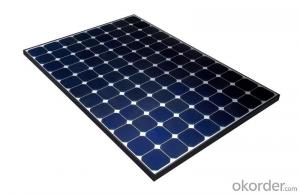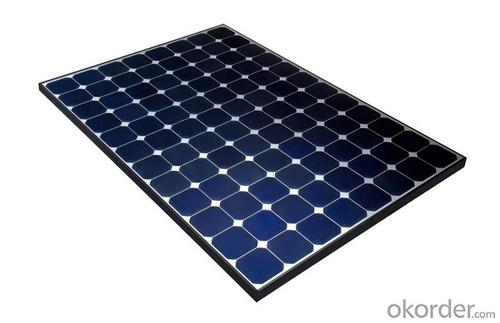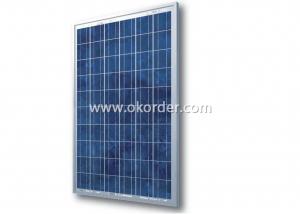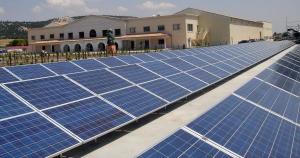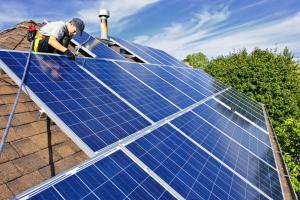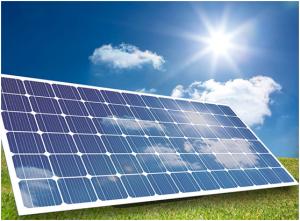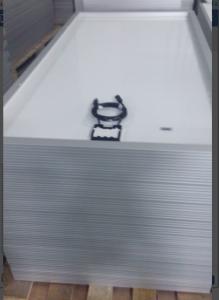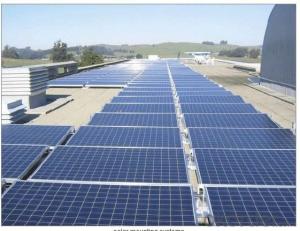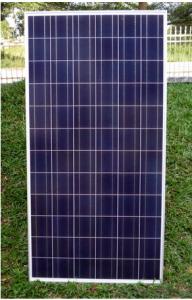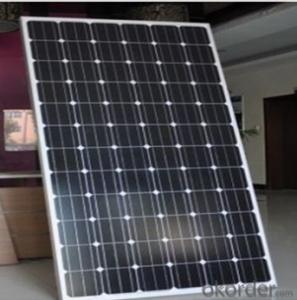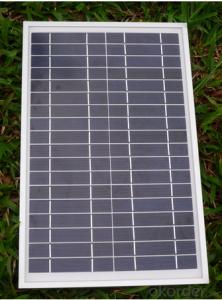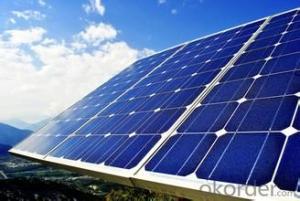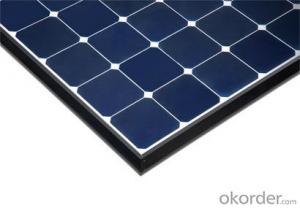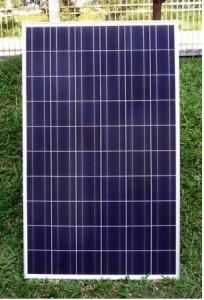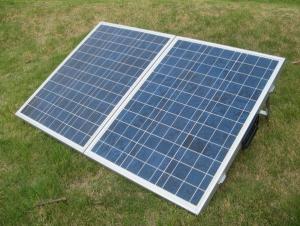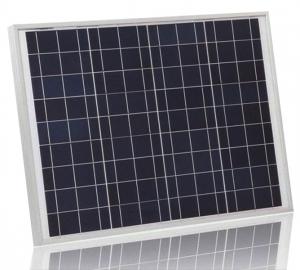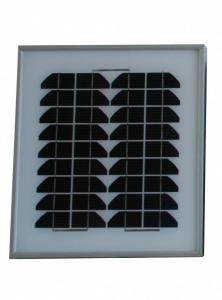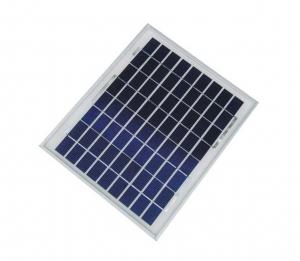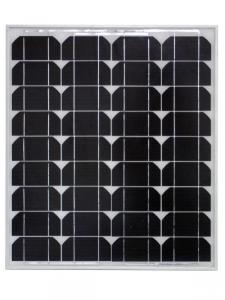Solar Panels Cartoon - Poly Solar Panel 130w B Grade with Cheapest Price
- Loading Port:
- Shanghai
- Payment Terms:
- TT OR LC
- Min Order Qty:
- 500 watt
- Supply Capability:
- 10000 watt/month
OKorder Service Pledge
OKorder Financial Service
You Might Also Like
Specification
Poly Solar Panel 130W B Grade with Cheapest Price
Product description
It is a form of photoelectric cell, defined as a device whose electrical characteristics, such as current, voltage, or resistance, vary when exposed to light. Solar cells are the building blocks of photovoltaic modules, otherwise known as solar panels.
Solar cells are described as being photovoltaic irrespective of whether the source is sunlight or an artificial light. They are used as a photodetector (for example infrared detectors), detecting light or other electromagnetic radiation near the visible range, or measuring light intensity.
A photovoltaic (in short PV) module is a packaged, connected assembly of typically 6×10 solar cells. Solar Photovoltaic panels constitute the solar array of a photovoltaic system that generates and supplies solar electricity in commercial and residential applications. Each module is rated by its DC output power under standard test conditions, and typically ranges from 100 to 365 watts. The efficiency of a module determines the area of a module given the same rated output – an 8% efficient 230 watt module will have twice the area of a 16% efficient 230 watt module. There are a few solar panels available that are exceeding 19% efficiency. A single solar module can produce only a limited amount of power; most installations contain multiple modules. A photovoltaic system typically includes a panel or an array of solar modules, a solar inverter, and sometimes a battery and/or solar tracker and interconnection wiring.
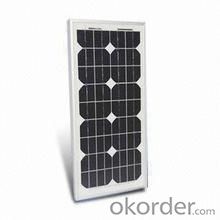
Application
Business
Home
Industry
Large project
Feature
1. A grade high efficiency solar cells.
2.TUV/UL/CE/CEC etc
3.Fast shippment
4.25 years warranty
5.OEM/ODM
Packaging
28pcs into one carton
Shipping
Material in stock can be produced (procedure 5-20days) right away after pre-payment confirmation. COSCO Mearsk MSCship to worldwide for safe shipping, don't worry about package damage or loss. It takes about 15-40 days to worldwide, Please note us your contact details include your phone number for easy contacting from shipping company officer.
- Q: I am building a solar panel I have wired in series 36 .5 volt solar cells to produce 8 volts I have another panel that has 34 .5 volt solar cells to produce 7 volts. Any issues with wiring these 2 arrays in Parallel? I.E. would the smaller array take usable power away from the larger array?
- The okorder /
- Q: Hi, I am starting to get curious about the pros/cons of installing solar panels - has anyone done it and is it worth it?
- Solar is mroe expensive than just about every other form of generation for a centralized plant, but can still be cost-effective for a consumer living in the right place. This is because while a coal-fired plant may produce electricity for 2-3 cents per kWh, by the time it's marked up to retail, distributed, and taxed to get to a residence, it may be 5 cents per kWh - a figure which solar can match in many places.
- Q: I want to make 2V 4.5A solar panel to charge my battery used in my RC car project. I just like to know how should I amplify the current for 4.5A. I need the total circuit diagram. Can anyone help me. Please. I need some affordable methods please.
- To increase current, you connect the cells in parallel. But I think you really mean you need 4.5 watts rather than 4.5 amps of current. For an RC car, 4.5 amps would be huge, literally a regular car battery. So I think you mean you need a 2v, 4.5w panel. That would make more sense for an RC car battery. I went on OKorder and bought a 2v, 5 watt panel for about $30.
- Q: I'm curious, for those who have had solar panels installed on the rooves of their houses:How much did you pay? How much energy do the panels produce? Did it dramatically cut down on your electricity bill? Was it worth it? Thanks!
- Is an SUV worth it? I have passed many of them off in the ditch while my 2wd truck keeps going on icy roads. Unless you own a company and need the SUV it will never pay for itself. Is a huge house worth it? I can live in a 8X6 foot house perfectly well. Unless you rent rooms out in the large house it will never pay for itself. Solar panels are statements to others like a house or vehicle, except they will actually pay for themselves over many years. Don't expect to get rich off them, but look at it as doing your part to cut down on pollution, become more self sufficient or whatever. The exception is if you build a house far from the grid. A friend was quoted $40,000 per mile to install grid tied power to her house out in the woods. Solar panels paid for themselves the first year there.
- Q: Can solar panels be installed on water bodies or reservoirs?
- Yes, solar panels can be installed on water bodies or reservoirs. This is known as floating solar or floating photovoltaic (FPV) technology. It involves mounting solar panels on buoyant platforms on the surface of the water. This approach offers several benefits, including reduced land requirements, increased energy generation due to the cooling effect of water, and reduced evaporation from the water body.
- Q: I have a question about solar panels. What are the benefits of this system if I installed in my home. for example i know it produces electricity but does it do anything else? How many panel would you guys think I would need for 2000 sq ft. do you know if it produces hot water? Thanks for your help
- Solar panels have been expensive, and not $00,000 about 30 to 50. There are new technologies that are just coming on line which supposedly reduce that for the same output by /2 to 2/3's which will, when these become widely available finally become practical, with tax breaks and incentives for the majority of people, either in their homes or businesses. I believe there are some panels that position the panels in such a way that you can buy a hot water collector under the photovoltaics and will produce hot water as well.
- Q: Can solar panels be installed on a data storage facility or server farm?
- Yes, solar panels can be installed on a data storage facility or server farm. In fact, many data centers and server farms are now incorporating solar power as a sustainable energy solution. By harnessing solar energy, these facilities can reduce their reliance on traditional electricity sources and lower their carbon footprint. Installing solar panels on such facilities not only helps them achieve cost savings in the long run but also contributes to a more environmentally friendly operation.
- Q: Due to erratic power cuts in my area I want to make up by using a 30watt solar panel. My decoder is 30watt but my TV is 70W. I need something small. I don't have problem with sound. Just picture.
- Do what we do when power is cut (although we have very reliable power - we loose as much as 2 hours a year), is go Amish. That is go without powered technology. Now, for you, you need more than a solar panel (and likely more than 30W, but that is a start) - you need a battery or set of batteries to store the collected power. 20Ah might do. You need an inverter to power things. For that, likely a 300W will do. For a TV, go shopping, and look at the labels on the back of the TVs. I just bought a 24 TV rated at 40W. If you get a 9 LED TV, it may be likely you can run that directly from battery, for many have separate DC brick supplies. With those, you can make a cable to power it directly from a 2V or so battery, if the supply can make 2 to 5V. Depending on your provider, you may be able to get a mini-decoder which uses a separate brick or wall supply, which means the decoder likely can be directly battery powered. Such a decoder may draw less than 20W.
- Q: How do solar panels affect the roof's integrity?
- Solar panels can have a positive impact on a roof's integrity as they act as a protective layer, shielding the roof from various weather conditions. Additionally, solar panels can help extend the lifespan of a roof by reducing direct exposure to sunlight, preventing damage caused by UV rays. However, it is important to ensure proper installation by professionals to avoid any potential issues such as leaks or added weight that could compromise the roof's integrity.
- Q: Can solar panels be installed on a warehouse or industrial facility?
- Yes, solar panels can be installed on a warehouse or industrial facility. In fact, these large structures often have ample roof space, making them ideal for solar panel installations. Installing solar panels on warehouses or industrial facilities can help offset energy costs, reduce carbon emissions, and contribute to a more sustainable energy future.
Send your message to us
Solar Panels Cartoon - Poly Solar Panel 130w B Grade with Cheapest Price
- Loading Port:
- Shanghai
- Payment Terms:
- TT OR LC
- Min Order Qty:
- 500 watt
- Supply Capability:
- 10000 watt/month
OKorder Service Pledge
OKorder Financial Service
Similar products
Hot products
Hot Searches
Related keywords
